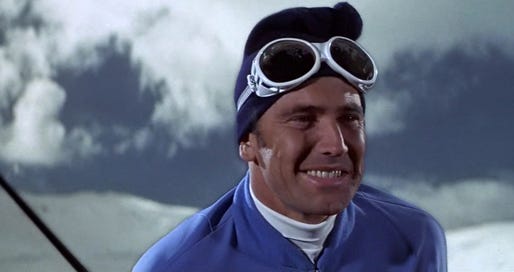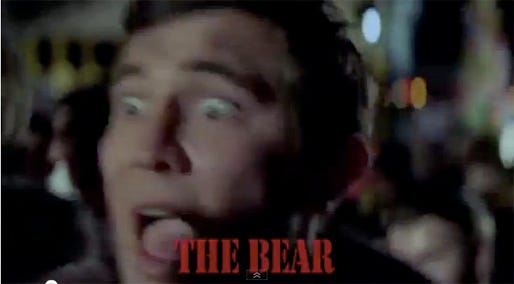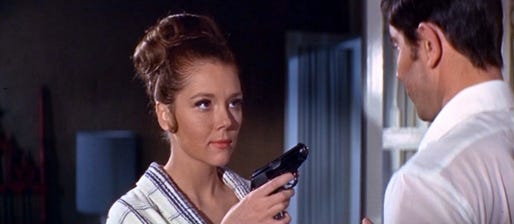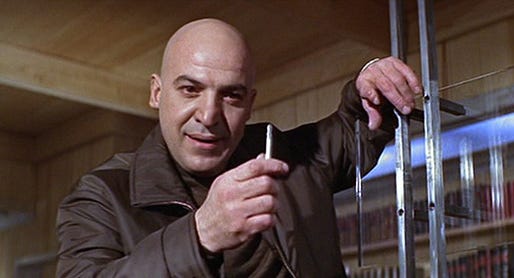You Only Live Twenty-Thrice: "On Her Majesty's Secret Service"
“You Only Live Twenty-Thrice” is a look back at the James Bond films.
Each Friday until the release of the 23rd official Bond film, “Skyfall,” we will revisit its 22 official predecessors from start to finish, with a bonus post for the unofficial films in which James Bond also appears.
In 1968, a no-name Australian model with zero film acting experience not only replaced Sean Connery as James Bond — based largely on an appearance in a chocolate-bar commercial — but was offered a seven-picture deal.
By today’s dollar standard, the Bond franchise was a $4 billion global asset. That would be like an oily-abbed stud plucked straight from a beer ad into a Jason Bourne reboot or an adorable teen who leaped straight from snacking on Skittles to starring as Spider-Man. Seriously, who wouldn’t take that deal?
Actually, that would be George Lazenby — who, on his agent’s awful advice, chose to be a one-and-done Bond after 1969’s “On Her Majesty’s Secret Service.” But what if Lazenby did what 99.99 percent of anyone else in his position would have done?
Roger Moore would have never become Bond; with a new film opening every two years, Moore would have been 56 when Lazenby’s contract expired. Had Lazenby’s films been big hits, and he renegotiated for more of them, perhaps no Timothy Dalton, either. Or, had Lazenby floundered and stalled the franchise, James Bond might have become a dusty relic — an archaic stiff unable to adapt to the upcoming personal liberations of the 1970s, as was Lazenby’s fear in the first place.
As it stands, “Service” is an odd interruption in the Bond canon. Although only "Dr. No" and “From Russia with Love” earned less actual money, “Service” was hardly a bomb, with $66 million worldwide in its initial run. It’s also neither an unsung masterpiece nor an unmitigated disaster; it’s half terrible, half tremendous.
And most of what works are action sequences not reliant on Lazenby to carry what he seems disinterested in even lifting. Even 33 years later, a helicopter siege, sleekly immersive ski chases and a brutal bobsled battle remain vigorously exciting. But those are all thanks to stuntwork, special effects and sly editing from John Glen (who would go on to direct every Bond film of the 1980s).
Case in point: Bond has commandeered outside help to launch an unauthorized assault on archrival Ernst Stavro Blofeld’s Swiss-mountaintop fortress and save his fiancée, as well as the world. Time is running out, and as the invading fleet of helicopters ascends, Lazenby scratches his face, casually glances out the window and occasionally smirks. It’s almost as if he doesn’t even know the camera is on.
In the absence of Connery’s effortlessness, you understand the importance of a Bond actor projecting confidence with posture, demeanor and body language. Lazenby fights just fine, but resembles a man who hasn’t grown into his gigantic body when attempting suavity — his face angled with creases like a plastic action figure. Worst of all, there’s a scene in which Bond gets scared by a … um … a camera-carrying bear as Blofeld’s minions chase him through a carnival.
Vulnerable, impulsive, impetuous, incorrect. Bond can be all of these things. But a ninny who makes that kind of face? Come on.
You may have picked up on “Service’s” other anomaly in a previous paragraph — Bond's fiancée. Yes, 007 proposes to Tracy di Vicenzo (Diana Rigg) while on the run from Blofeld. Bond married for a mission in “You Only Live Twice,” and it seems to start that way here, too. But in time, he does fall in love. It’s too bad the movie devotes too little time to their chemistry and too much toward silly, sexual shenanigans in Blofeld’s fortress, as it culminates with an emotional gut punch unmatched until 2006’s “Casino Royale” during which Lazenby does his best work.
This grim finale clashes with goofy frolicking that goes on far too long in first and second acts as uncomfortably twitchy as Lazenby. The actor holds his own physically in a pre-credits sequence, in which he saves a suicidal Tracy only to be accosted by thugs. There are walloping hooks and uppercuts, and you can see the hand of director Peter Hunt, longtime editor and second-unit director for the Bond films, at work throughout. Then it ends with an all-time series low for dialogue.
Lazenby’s groaner breaks the fourth wall and the next 90 minutes of the movie — a good deal of which are riddled with reminders of the Bond that used to be, not the one you’re actually watching. Why does a midget janitor whistle “Goldfinger”? Does Bond need to find gadgets and reminisce while we hear other previous themes?
And as majestic as John Barry’s opening-credits instrumental sounds (even if its orchestration slouches a bit toward the ’70s), the fluttering footage from past films says, “Hey, remember all those movies you loved? We’re not sure if this one’s going to measure up, but we’ll give it a shot if you will!” (On a side note, it was wise to not cram the syllabically twisty “On Her Majesty’s Secret Service” into any song lyrics.)
We soon learn Bond has spent the last two years pursuing Blofeld (now played by Telly Savalas) after he escaped at the end of “You Only Live Twice.” Disappointed by a lack of results, M (Bernard Lee) yanks Bond from the operation, at which point Bond writes a letter of resignation as a bluff. But the always-sly Moneypenny swaps it with a letter requesting time off, which M graciously grants.
While vacationing in Portugal, Bond is summoned by Marc-Ange Draco (Gabriele Ferzetti), both a criminal with tangential ties to Blofeld’s SPECTRE and Tracy’s father. Essentially, Draco wants Bond to marry the seemingly unstable Tracy and, it’s implied, screw her into complacency. In doing so, Draco dangles a carrot in front of Bond — Blofeld’s whereabouts.
After a tidy courtship montage with Tracy (underscored by Louis Armstrong’s sweet “We Have All the Time in the World”), Bond heads to Switzerland. At the Alps’ highest peak, Blofeld has established an “allergy institute,” and Bond pretends to be a genealogist responding to Blofeld’s request to be named a count.
For at least a half-hour, George Baker (who plays the real genealogist) overdubs Lazenby’s voice. (So shallow was the filmmaker’s trust in Lazenby that they didn’t rely on him to affect a different accent.) And never mind that Blofeld and Bond faced off in “Twice.” “Service’s” original script included a plastic-surgery reference to explain Bond’s new face, but as it is, the movie simply disregards existing continuity.
Forgoing that, “Service” still has a great setup: Bond is exiled to a snowy summit, utterly isolated from amenities and allies. Obviously, the next 30 minutes should dress him in silly kilts, enter him into informal curling competitions, pair him with 10 buxom ditzes for dinner, and sleep with two of them after discussing the “gold balls” that are the symbol of his family line.
Never before has the narrative dictum that Bond sleep with three women been so arbitrarily thrown together, and that’s saying something. Mind you, Hunt sought to make a more realistic Bond film than the immediate predecessors (and would, coincidentally, never be involved with a Bond film after this one). So why not have Bond resist the urge to be a lothario and save his affections for Tracy? It’s not so heartfelt when he says the “L” word after boning two leggy models in a previous act.
Eventually, we learn Blofeld is brainwashing these women to be “angels of death” — releasing a biochemical agent that will destroy the planet’s plants and food supply. After Blofeld “discovers” Bond’s identity, so begins a race down the mountain to alert MI6.
Save Lazenby’s aforementioned ninny-face and dispassionate helicopter ride, the film is virtually flawless from here on in — beginning with one of two unforgettable ski chases. Cameramen followed the actors and stuntmen with handheld rigs and Lazenby broke his arm during filming, further angering producers.
Bond makes it to Lauterbrunnen — a small village halfway down Blofeld’s mountain — where Rigg’s strong-willed performance makes up for Tracy’s unexpectedly huh-what arrival there.
Rigg, who played Emma Peel on the British TV show “The Avengers” from 1964 to 1968, rebounds nicely from a first act in which Tracy is saved, sexed or slapped around by men. Ultimately, she makes Tracy one of the best Bond girls — as resourceful as she is romantic as seen in a pulse-quickening car chase on an icy track. Tracy is sexy in a schoolmarm sort of way, dangerous in a bipolar way and given the strongest wills and skills of any Bond girl yet.
She joins 007 in a second ski chase during which Blofeld triggers an intense avalanche — a combination of stock footage, miniatures, visual effects and stunt work. That’s preceded by an uncharacteristically bloody end for a henchman, ruined by a Lazenby eye-roller to which Rigg’s reaction suggests, “Shut up and ski, newbie!”
Also, you’ll notice Blofeld’s active pursuit. It’s nice to see Blofeld toss his cat aside and partake in some brutality. However, Savalas is saddled with ridiculous monologues (“I’ve taught you to love chickens, love their flesh”) and an unfortunate, unintentionally hilarious choice to have him puff his cigarettes vertically.
An assault on Blofeld’s stronghold is damn good, too, although it’s telling that the “James Bond Theme” plays primarily over Tracy fending off a henchman instead of what Bond himself is doing.
And last, but certainly not least, is the bobsled chase. It feels like the be-all, end-all, high-stakes battle between Bond and Blofeld that it should be — complete with one helluva stunt as Bond’s bobsled explodes.
After nearly an hour of expertly executed hold-your-breath tension, “Service” exhales James and Tracy’s wedding. And it’s there that Lois Maxwell’s Moneypenny follows up emotional honesty in “Twice” with a briefly tearful moment that sees the man she’s finally molded into marriage material choose someone else.
Oh, but were the film to cut away as James and Tracy drive off in a vehicle adorned with streamers.
It’s almost cruel to hear the “James Bond Theme” kick in after that. (Hell, even “24” gave people the silent clock every now and again.) And as bumbling as Lazenby has been, he’s utterly devastating there, with just the slightest suggestion of tears. James finally throws his lot into what he believes to be a symbol of happiness, peace and safety … and what does it get him?
Had the film emphasized more strongly its tragic irony — that James saves Tracy but only pulls her closer toward death — that moment would be a masterpiece. Still, it does linger as an unexpected ending that, had Connery not returned, could have served as The End.
Of course, an astronomical paycheck lured Connery back and returned the character to a place of cheeky glitz where he forgot all about Tracy di Vicenzo. As for Lazenby, he later spoofed the Bond role on TV, starred in more soft-core Emmanuelle films than Bond films and wrote an upcoming autobiography called “The Other Fella.”
His last name also became synonymous with mark-missing performances of iconic characters. That last scene aside, Lazenby is fairly inept. But the filmmakers are also to blame — trapping “Service” in a netherworld between making its own statement and desperately trying to remind us of everything we liked hearing Connery say.
Next week: "Diamonds Are Forever"
BULLET POINTS
At 140 minutes, “On Her Majesty’s Secret Service” was the longest James Bond film until 2006’s “Casino Royale” clocked in at 144 minutes.
In 1976, ABC showed the film over two nights, broken into 90-minute halves. However, to pack more action into the front half, the network created its own edit — beginning the film with the first ski chase, adding awful narration and implementing flashback structures the film doesn’t use. If you dare, the first 43 minutes of that bastard version:
George Lazenby is the youngest actor to ever play Bond, 29 when he took the part.
Producers offered the role to Timothy Dalton who was then just 22 years old. He wisely declined, saying he was too young and inexperienced. Had they cast him, would Bond have to show his ID when ordering a drink?
Brigitte Bardot was initially sought to play Countess Tracy di Vicenzo, but she declined to star in “Shalako,” a Western starring none other than Sean Connery.






